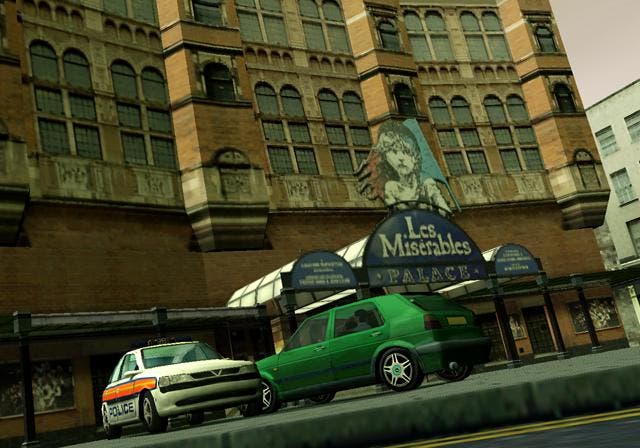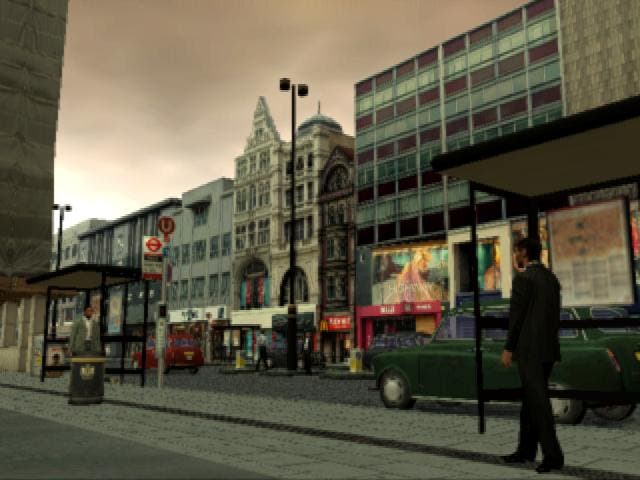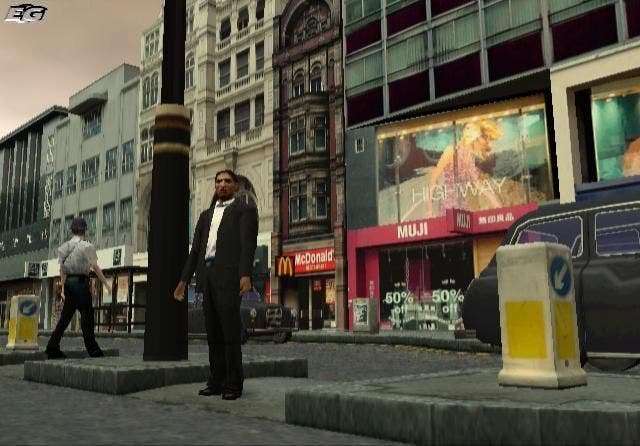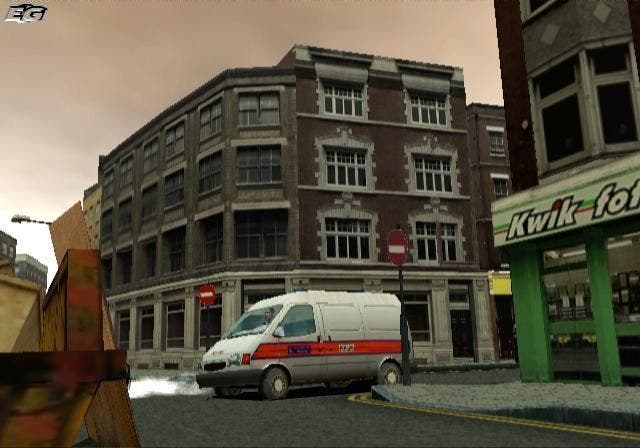The Getaway
Review - everyone is fighting
28 square miles of central London, painstakingly recreated for your gaming pleasure, 50 real life vehicles to drive around in, 24 missions of stealth action and an hour of cut scenes featuring torture, murder, gang warfare, racism, and some hard core swearing are just some of the things you'll find in The Getaway, and no one in their right minds should dare criticise Sony for lacking ambition in this era of sterile rehashes and sequel obsession.
It goes without saying that The Getaway is an ambitious project, but then the Millennium Dome was ambitious; that doesn't give it the right to be immune from extensive analysis and criticism. Anything that a) claims to break the mould, b) takes years to make and c) costs multiple millions better be bloody good, or it runs the risk of buckling under the weight of indignant, spiteful criticism from an expectant, demanding community.

We wish we'd known nothing about it
If The Getaway had emerged from nowhere it would be easier to be impressed. Hype isn't a prerequisite to having a big hit; remember how GTA3 stealthily emerged with virtually no pre-release activity, and then became the biggest word of mouth hit ever? As a result of the unrealistic hype and the years in the making, many assumed The Getaway wouldn't be any good even before they'd played it. A wonky E3 demo hardly helped, replete with less than forgiving handling, a hard to grasp combat system and frame rate issues - all of which resulted in some of the most vitriolic pre-release coverage ever seen.
But sod the deafening wall of negativity - we wanted to make our own minds up. As with any game, the first thing that strikes you is the visuals. The recreation of London is, a month after our first impressions, still an astounding technical achievement on such a relatively limited piece of technology. While it's clear that compromises have been made (some shop signs are missing, there are no road signs, smaller roads have been blocked off, no parked cars, etc), the overwhelming sensation is that Team Soho has pulled off something very special indeed. In the main it looks right; the graphics are crisp and clear, there are no loading delays to speak of, almost no discernable pop up and no major frame rate issues. It's no small praise that Sony could have released this as a London Simulator without the missions or cut scenes and people would still have had fun playing it. It would have been a bit pointless, but as a curiosity it's alluring enough as it is just to bomb around London playing the happy tourist.
If you're a Londoner, or have plenty of experience driving around London, it's an almost surreal experience driving around places you've known for years in a videogame. You find yourself pootling about, doing your drive to work, driving to a mate's flat to see if it's really been recreated, checking out the bits you know and exploring the areas you don't. On this basis alone it's probably worth buying, and we haven't even talked about the missions and the plot yet.

The first mistake
Strangely, Sony has elected to lock the Free Roam mode (it was unlocked in the preview build), meaning that you have to play through all 24 missions to access the facet of the game we have been evangelising about, which is Team Soho's first mistake.
The real meat of the game centres around the arch villain Charlie Jolson, a despicable, ageing racist gang leader who has decided it's time his Bethnal mob were top dogs in London once again. The game kicks off with a kidnap attempt of a young boy, who happens to be the son of the game's first playable character, Mark Hammond.
The kidnap goes tits up, and Hammond's wife is left dead at the scene - which is where the game kicks off. The disconsolate lead character is thirsty for revenge, and very soon he's up to his neck in trouble, with not only the law on his back, but rival gang members too.
Evidently, Hammond will do just about anything to get his kidnapped boy back, even if it means taking out his former associates, wiping out an entire police station or any number of Triad or Yardie gang members.
The story itself is actually one of the better we've witnessed in a videogame - and with over an hour of cut scenes, interspersed across the 24 missions (12 as Hammond, 12 as Frank Carter - a member of the fuzz) you're regularly rewarded with new clips. Sadly the voice acting, while not bad in videogame terms, comes across as forced and low rent in comparison to the real deal. Vice City proved beyond all doubt what can be achieved when you get name Hollywood actors involved, and given the game's big budget, we're slightly disappointed that Sony's budget didn't stretch this far. (After all, The Actor's Centre is but half a mile down the road from Team Soho). We'd like to say it doesn't suffer through the use of name actors, but we'd be lying.

See You Next Tuesdays
The liberal use of swear words would embarrass a Touretts sufferer, never mind the more mild mannered among you and will no doubt result in a 'shit storm' down at the Daily Mail's newsroom sometime soon. It really is peppered with everything bar the still taboo 'See You Next Tuesday' word and uses them as regularly as possible. Even driving around, passers by take every opportunity to rebuke your shi... sorry, terrible ability to control your vehicle. Some would say this amount of bad language is unnecessary, but seeing as it's an 18 certificate, we say 'bollocks' to that. If you don't like it, don't buy it, but it's nice to see publishers taking risks and deliberately doing something adult, even if it doesn't quite hit the mark. Sony has probably done more to take gaming away from its perceived kiddie heartland than any other company, and The Getaway is proof that gaming entertainment can be just as compelling in real world settings (and how refreshing to play a game based in the place that you live, in a modern day environment).
So what of the gameplay? Essentially The Getaway is two distinct games in one - equal parts driving and stealth shooting. The driving element generally involves getting from point A to point B; sometimes this involves a time limit, other times a bit of destruction. Playing as Mark Hammond, you're often on the run from the law and various gangs at the same time, so it can pay to stick to one way systems, traffic signals and avoid crashes - because the police come down on you like a ton of bricks. The handling is totally different to the GTA model, and as such is far more realistic, and therefore harder than Rockstar's classic. Smashing up your car, or having your tyres shot out has a noticeable effect on your handling - which makes it even more important to be a bit more careful when you're haring around like a maniac. If you find yourself taking too many knocks, the engine will start to smoke, before eventually catching fire, giving you just a few seconds to get out before you too become engulfed in flames.
Fortunately, there are always dozens of other vehicles to hijack, and the system of capture works almost identically to GTA, except you press circle. All the cars are realistically modelled, and thus handling, speed and even engine sound is recreated. Sometimes, though, when you're on the run, beggars can't be choosers, and even a Renault Clio is better than a knackered Lexus. Sadly though, Sony missed the opportunity to emulate London radio stations and without a musical accompaniment all you're left with is a roaring engine and indignant pedestrians to keep you company. Presumably, this was a budgetary issue, but most gamers will be asking Sony "if Vice City has real music, why not The Getaway?", and they'd have a valid point. It's sorely missed.
The damage modelling is convincing to a degree - windows get shot out, tyres burst, front and back end damage can look extremely realistic, but it's no Burnout 2 in this respect. There are some nice touches, though. If one of your tyres gets a puncture, you can get out of the car and shoot the other side to balance up the handling - although eventually you'll be driving on your wheel rims.

Murder, Death, Kill
If you're particularly fed up with your pursuers, you can kill them - as you'd expect. Pressing square brings out your gun, and tapping R1 targets your nearest aggressor, with a further tap on square firing the weapon. If you're just feeling murderous, you can manually aim at whatever you choose by holding down R2, and aim with the left stick. It's a system that feels clunky at first, but fairly natural after a couple of hours.
The 'off road' missions generally take place indoors, and almost always rely on a liberal use of stealth. While it is possible to charge in and try and blast through like a hero, you'll probably be dead within about 10 seconds. Instead, you get far more reward for taking your time, sidling up against walls, peeking around corners and using cover wherever possible. At first this element of the game can feel hideously clunky, but after a while becomes by far the most enjoyable part of it.
Usually backed up by some atmospheric 'Professionals' style music, you find yourself slowly picking your way through levels, with a limited, but very cool array of moves - none more so than the one that enables you to poke your weapon around a corner and fire blindly. Given that the game controls the camera for you, you're always aware when an enemy is approaching - so long as your back's against the wall - and picking off enemies like this is immensely enjoyable. Slightly jarring is the less than perfect animation - Hammond lumbers around like someone who's been caught short - although it's never something that gets in the way of the overall game.

Superbly realised environments
The indoor locales are always richly detailed - possibly some of the most well realised game locations we've ever seen, and the in game chatter between the non player characters creates a supremely convincing environment. Check out the Snowhill Police Station, or the Yardie's crack den. They're superbly realised, and as such act as huge incentives to play through to the next stage. Not matter how stuck you get; the urge to find out what happens next never lets up.
However, having recently played Splinter Cell, it's apparent that as a stealth based shooter it falls way short of the majesty that Ubi Soft's title manages. For a start, the game assumes total control over the camera - which often works against the player, and often makes assumptions that cause you to miss things that are about to kill you.
The AI, while certainly not perfect in most games, can be inconsistent and unpredictable. In one mission, as DC Frank Carter, you're expected to sneak about without getting anyone's attention. Some of the time your foes don't spot you when you're stood six feet away from them - while other times they seem to have X-Ray vision, with an irritating ability to see through walls. Meanwhile, most of the time, if their back is turned you can more or less run right up to them - while they carry on oblivious.

Keep it clean, son
In something of a first, Team Soho has decided to keep the interface clean, so there are no icons on screen. No health bar, no ammo meter, nothing. It gives the game less of a videogame look, (and hence, more of a movie-esque feel) but it does create obvious problems: how much ammo is left? What's the health situation? Which road are we on? It's not a major issue, but it would have been helpful, at the very least, to enable players to decide for themselves whether they needed on screen information (and wouldn't it have been cool to have bundled a mini A to Z with the game to enable you to check your route in-game?).
Also, some gamers will be disappointed to learn that there are just three weapons in the whole game. While this does lend a degree of realism to the experience, the average gamer is constantly looking forward to the next gadget to get to grips with. The fact is that in The Getaway, you've seen all the weapons within a matter of minutes - and frankly after all the years in development that seems a bit of an oversight (especially stood next to Vice City and its plethora of killing implements).
Based on the missions alone, the game won't last as long as you'd think, either. One of the best bits of the preview version was the fact that when you got shot to near death, you could recover a few more hits and stagger on if you leaned up against a wall. In the finished build, the game, bizarrely, allows you to restore your entire health if you stand up against a wall long enough. This reduces the element of tension dramatically, because most gamers will - with a bit of patience - be able to rip through the missions within a few attempts. To give you an idea, a month back it took us about 12 hours to finish all 12 Mark Hammond missions. With the finished build, we blitzed through the 12 Frank Carter missions in just over four. Admittedly, the Carter missions are easier; thanks to the driving sections not requiring avoidance of the law, but still, it was a disappointingly straightforward way to round off an otherwise entertaining experience.
We feel sullied
Perhaps the most interesting thing about The Getaway is the way you feel when you're engaging in such acts of gratuitous violence. At no time does it feel like you're killing for fun - and under no circumstances would you ever feel justified letting a young child get to grips with such carnage. GTA this most definitely isn't, and even though you want to help Hammond get his boy back, it defies belief how the game descends into a black hole to make you achieve this. While most of the people you kill in the game are hardened criminals (and some may arguably deserve to die), you do find yourself taking out hoards of 'good guys' (such as in the horrendous Police Station level). The overtly racist jibes of Jolson and his henchmen also feel uncomfortably near the knuckle. Some would argue that even movies wouldn't push things as far as The Getaway does in the respect, and it would be no surprise at all for an almighty stink to emerge from this aspect of the game.
Despite its frustratingly imperfect state, The Getaway is still a tremendously enjoyable experience. On a technical level it's a major achievement, with a superbly realised graphics engine, but on a gameplay level it's neither the best driving game, nor the best stealth-based shooter, and some of you will have issues with the hammy voice acting (and maybe the race driven plot). As a template for the future, The Getaway is a very solid base to build on. A more authentic looking, more interactive environment, a less linear mission structure, use of name actors and some killer tunes would make an amazing sequel. But for now, The Getaway still has more than enough to deserve your attention, and will be one of the few games you'll want to play to the very end.



